In the Blues the Lowered 3rd and 7th Notes in the Scale Are Known as
The Blues Scale is a minor, hexatonic scale with the scale degrees 1 The Blues Scale is... I'm currently expanding this list, but lets look at some of these misunderstandings in a bit more detail: It's really not. This comes from Wikipedia. The source they cite for it is Smallwood, Richard (1980). "Gospel and Blues Improvisation" p.102, Music Educators Journal, Vol. 66, No. 5. (Jan., 1980), p.100-104., That definition is there, however its mentioned in passing (and in parentheses no less). On the preceding page he gives several examples of blues vocal lines, written in standard music notation. Every single example he gives is made up of only notes from the actual real deal six note Blues scale, NOT this "heptatonic" construction. Leading me to believe an editor may have "corrected" the definition from his original draft, because he clearly knows what the blues scale is. Even if we put aside the discussion of what six scale degrees are in it or what notes we might might add to it or alter in it in a given circumstance, the core scale has to be hexatonic, We accept without reservation that Bebop scales have 8 notes and that the eighth note has been added so the scales will run more naturally in 4 rhythms. Given the dominance of rhythm in blues music, and the importance of 3 based rhythms, why do some refuse to accept the idea that the core scale of the genre has 6 notes? These two statements amount to largely the same thing. Rock, Blues, and Metal are based on the blues scale and how it functions. In jazz, the Blues scale is used occasionally and largely for effect by the majority of Jazz musicians. Jazz harmony is based primarily on the Major scale. Even over minor chords, Dorian mode is the most common choice. It is a genre identifying maneuver of jazz (abbreviated jazz cliche) to always play the natural 6th over minor chords. Why? Because it sounds, well, jazzier. The blues scale doesn't have it, this is simply some jazz guys with free time and fast internet trying to make it into a scale they feel more comfortable with. The flatted fifth scale degree, aka the To summarize, the Minor Blues Scale has these scale degrees: 1 Built on the root note A we have a spelling of A C D Eb E G. Since it contains a flatted third and a natural fifth, the Minor blues Scale is, by definition a Minor scale. This is the scale you see in the sidebar to the above right. Call it the Blues Scale or call it the Minor Blues Scale, it doesn't matter, they mean the same thing. A stated earlier, the Blues Scale can be played over different types of chord progressions. The rule here is pretty straightforward: If a song is in the key of A minor, we can play the A blues scale straight through the whole solo. If a song is in the key of A Major, we can play the A blues scale straight through the whole solo. If a song is in the key of A whatever, we can play the A blues scale straight through the whole solo. Won't some notes clash in some situations? Yes. The Pentatonic Minor scale is one note short of the Blues scale, and loses a lot of the blues scale's ability to function over pretty much any progression. The note its missing is the flatted (or diminished) 5th scale degree, better known as The Flat Five or the Blue Note. When playing the Pentatonic Minor over an entire chord progression, you are really playing the Blues Scale, in a stripped down or musically simplified form. Its actually more the exception than the rule to hear an "all Pentatonic Minor" solo without hearing the 4th scale degree bent towards the 5th to sound the The Pentatonic Minor is the skeleton or framework of a Minor scale with a flat seven. If you look to the pictures on the right, you will see 4 of the most commonly used minor scales in modern music (Hexatonic Minor being far less important than the other 4). The 5 scale degrees they have in common form the Pentatonic Minor scale (Pentatonic Minor notes are in black). The other notes give the scales their distinctive sounds, and are called color tones (sometimes character tones). The Major scale is the dominant scale in European Classical Music and in music theory in general. Even those of us who play music based on the blues scale accept this; we number notes in a scale (which we then call scale degrees), by convention, in terms of the major scale (Major gets the numbers: 1 2 3 4 5 6 7, no sharps or flats). But is this our "go-to" scale for playing a stadium, and will it sell even a single beer at the local rock 'n' roll dive bar? Probably not. Although of immense theoretical importance, riffs and solos in Rock, Blues, and Metal are very seldom based on the Major scale. If you are starting out on Rock, Blues, or Metal guitar, or are just starting to play lead guitar, you need to master the Blues Scale first. Not because it's easy but simply because the Blues Scale is the single most important scale to know. The Blues Scale, not the Major scale, is is both historically and theoretically the foundation of all of three genres (and their sub-genres). I'll just come out and say it point blank: If you can't play the Blues scale you suck at Rock, Blues and Metal. Yes, you do. There's really no nice way to say it, but there's really no need for a nice way to say it, its just fact. Most guitarists shouldn't even bother with the other scales until they have a good command of the Blues Scale (aka the Minor Blues Scale). It is worth more than all the other scales on this site put together. The C Major scale is probably the easiest scale to learn on piano and is the starting point of many piano methods, whose primary aim is to teach students to play European Classical Music, a genre where the Major Scale is the undisputed king. Most guitarists, however, play popular music of varying degrees of heaviness. These genres have at their core the Blues Scale, which you should learn first. You should still learn the Chords for Major keys (along with the chords for Minor keys)which are in the Chord and Arpeggio Diagram section of this website. Most music books and many website articles are written by music professors. You don't get tenure in a university by mastering Death Metal, Rock 'n' Roll, or Surf Punk, they play Jazz or Classical guitar and teach jazz or classical students all week long. So what they recommend is true in their musical world, but doesn't necessarily coincide with what most guitarists want to play. Are they biased? Absolutely. Please do not mistake me for some kind of impartial voice of musical reason. I am completely biased myself, just towards the other side of the guitar spectrum. I have no problem with them teaching the styles of music they love. I do the same. My problem is when books, websites, magazines, teachers, etc. do not indicate what styles they are presupposing as a foundation. It makes it way too hard for beginners to figure out whats going on. There are also some truly excellent heavy metal oriented sites out there that skip over the blues, because they assume you've already aced "Black Sabbath 101." The Guitar neck diagrams take forever to make so they choose to focus on the more exotic and evil sounding scales. To summarize, you have to know the chords in Major keys and the Chords for Minor keys , these are essential. But learning the CAGED system patterns of the Major scale and improvising leads with it is of minimal importance in the beginning (unless you play Jazz). As mentioned earlier, although we rarely, if ever. use the Major Scale for riffs and guitar leads, scales degrees are numbered, by convention, with the Major Scale as a baseline. This is just fine, as we need to set something as the baseline, and this way we use the same numbering system as the other musical styles. But again, please avoid thinking of the Major scale as the Master scale, because in reality the Blues Scale is. So here's how it works: So, for example, if we took an A minor 7th chord (written A-7 or Am7) which normally has a  Companion to the Blues Scale Guitar Lesson and Chart
Companion to the Blues Scale Guitar Lesson and Chart The Blues: King of all Guitar Scales
Blues Scale Feature Guitar Lesson
What is the Blues Scale?
The Blues Scale: Construction
The Blues Scale has:
The Four
).What the Blues Scale Is Not
What the Blues Scale IS
The Blues Scale...
The Blues Scale: Fact and Utter Fiction
FICTION: The Blues scale is heptatonic.
FACT: The Blues scale is hexatonic
Fiction: The Blues Scale is Primarily a Jazz Scale
Fiction: The Blues Scale has a Natural 6th (aka Major Sixth) Scale Degree
What the Heck is the Blue Note?
flat five
, is also called the Blue Note, as the addition of this note to the Pentatonic Minor Scale forms the Blues Scale, and radically changes or colors the sound of the scale.The Blues scale: a Summary
"Minor Blues Scale" vs. "The Blues Scale"
The Blues Scale Name Game
(Minor) Blues Scale Usage
The Minor Blues Scale vs. Minor Pentatonic
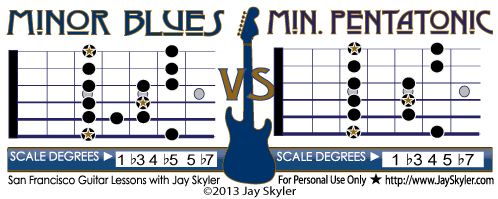
Note: As this website is focused on, and to be honest, biased towards Rock, Blues, Metal, and Folk guitar styles, all references to The Pentatonic Minor Scale will refer to the scale constructed with scale degrees
The Differences Between Blues and Pentatonic Minor
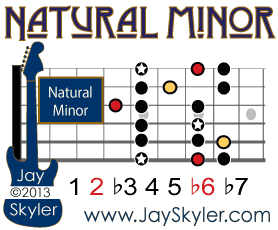
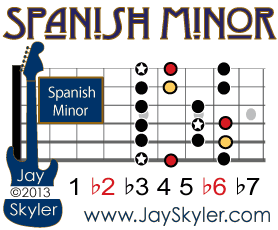
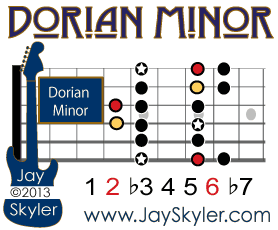
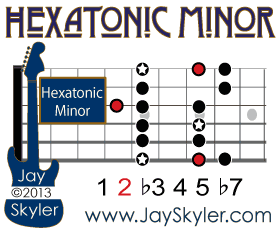
The Pentatonic Minor is the 5 Common Notes of Minor Scales with a b7
Standard Blues Progressions

The Blues Scale vs. the Major Scale on Guitar
A Warning for Rock, Blues, and Metal Guitarists
Isn't the C Major Scale Most Important?
The Major Scale Conspiracy
But this book / other website / magazine said the Major Scale is the most important scale to be able to play!
Why? Ask yourself who writes this stuff.We are talking here about The Major scale or Ionian mode not the Major Blues scale which is something different as you can see in the picture below:
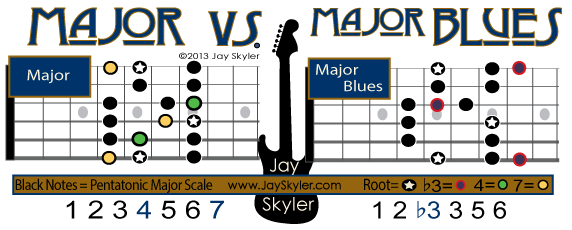
Blues vs. Major Scale Summary
The Major Scale is the Baseline for Theory
The articles and diagrams on this site are provided free for personal use, without ads, and no personal information is collected or sold. If you have found this information valuable, please consider making a donation of any amount at https://paypal.me/JaySkylerGuitar Thanks! Jay Skyler
The charts and articles on this site are 100% my original copywrited writing and artwork. They may not be reproduced or modified without express written permission from Jay Skyler. They may not be linked to any site except www.JaySkyler.com. I file copyright claims with any platform they appear on if these terms are violated.
fletcherhustraings.blogspot.com
Source: https://www.jayskyler.com/guitar-lessons-san-francisco-theory/blues-scale-guitar-theory.html
0 Response to "In the Blues the Lowered 3rd and 7th Notes in the Scale Are Known as"
Post a Comment